
The Solar-Terrestrial Centre of Excellence (STCE) is a collaborative network of the Belgian Institute for Space Aeronomy, the Royal Observatory of Belgium and the Royal Meteorological Institute of Belgium.
 |
Published by the STCE - this issue : 16 Jan 2015. The Solar-Terrestrial Centre of Excellence (STCE) is a collaborative network of the Belgian Institute for Space Aeronomy, the Royal Observatory of Belgium and the Royal Meteorological Institute of Belgium. |
| Archive of the newsletters | Subscribe to this newsletter by mail |
On 7 January, a strong geomagnetic storm (Kp=7; see the NOAA scales at http://www.swpc.noaa.gov/noaa-scales-explanation) was observed. The solar wind magnetic field turned southward with maximum values of -21 nT, which is even a bit stronger than the 12 September storm from last year (-18 nT; see http://www.stce.be/news/268/welcome.html).
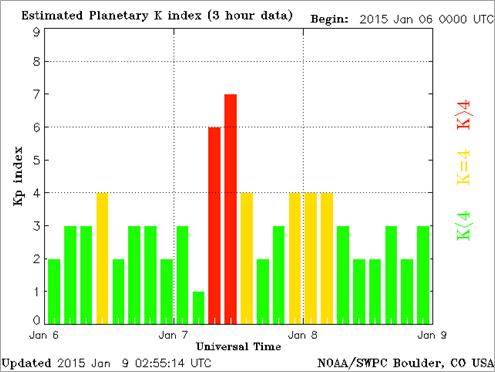
This geomagnetic storm took the space weather forecasters by surprise. Most expected active to quiet conditions (Kp = 4 or less) for 7 January as the geomagnetic field was recovering from the effects of a high speed stream from an impressive coronal hole near the Sun's south pole.
Usually, examination of the ACE solar wind data (http://www.swpc.noaa.gov/products/ace-real-time-solar-wind) already reveals some clues concerning the source of the disturbance such as a coronal mass ejection (CME) or the high speed stream from a coronal hole (CH). In this case however, there was no clear shock observed in the solar wind speed (yellow curve below), which was not in favor of a CME. The solar wind speed only gradually increased from about 420 km/s around midnight to a maximum of 480 km/s about eight hours later. This low speed is also not very typical for a CH, and on top of that, the low temperature (green curve) and rather high density (particles per volume unit; orange curve) seemed to further exclude a CH as the source for the disturbance.
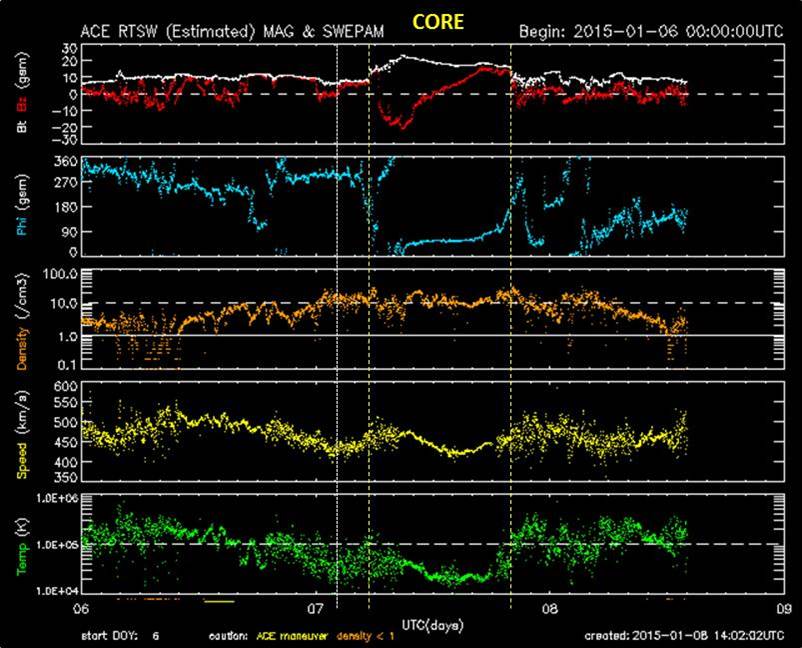
Hence, the current consensus is that this was a CME after all, based on the evolution of the orientation of the magnetic field (red curve above). This started slightly positive (northward oriented) between 02:00UT and 05:30UT. Then, as the core of the disturbance passed, the field quickly became strongly negative for about 4 hours, gradually turning northward (+15 nT) again before returning to nominal levels around 20:00UT. This is indicative for the rotation of the magnetic field of the core of the disturbance, thus favoring a CME over a CH, despite the lack of a shock in the solar wind speed. This happens occasionally, and a similar case was already discussed in this news item at http://stce.be/news/177/welcome.html
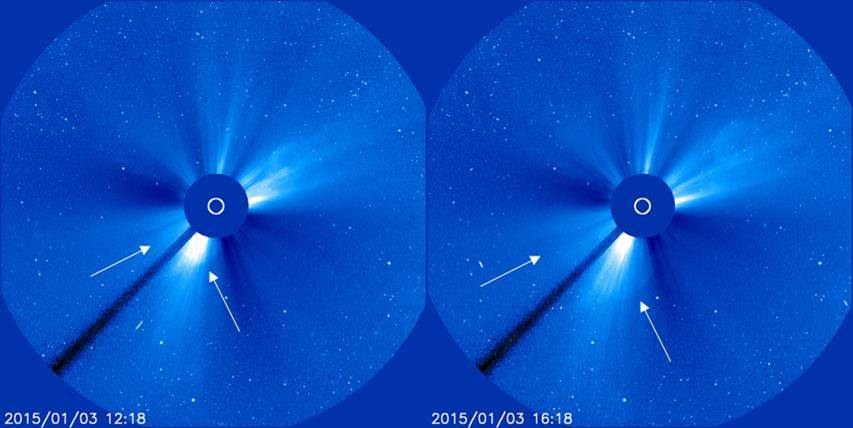
So, the obvious question now became where this CME was coming from. From the observed solar wind speed at Earth, a CME would be expected to have lift off somewhere during the weekend. Also, no shock was observed, so it should be a relatively slow CME too. As it turns out, not many CMEs were observed during that time frame by SOHO's coronagraphs (http://sohowww.nascom.nasa.gov/). In fact, there's only one serious candidate: A weak, diffuse CME directed to the southeast observed on 3 January, with a speed of only about 150 km/s (image above). Initially, forecasters thought this CME was not going to be directed to Earth, but now, after careful examination of difference images (one image subtracted from the previous), it seems there might have been a very faint earth-directed component. See the annotated difference image from CACTus (http://www.sidc.oma.be/cactus/) underneath.
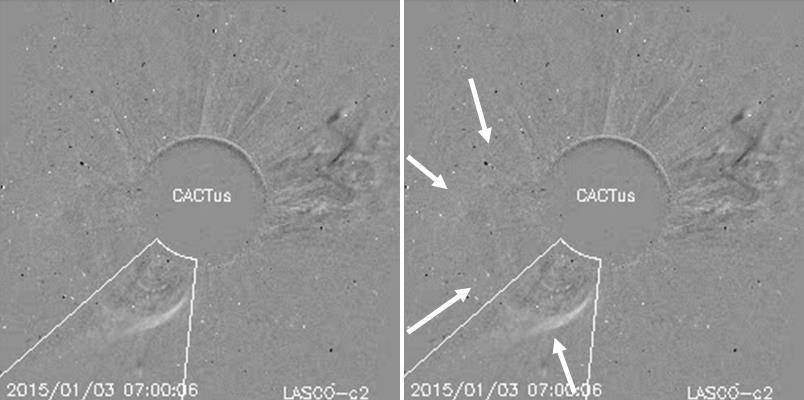
Linking this CME to some eruptive event on the solar surface was not so obvious. For example, the CME is not related to the M-class flare that took place on 3 January peaking at 09:47UT. Indeed, the CME was already visible several hours prior to the flare, and the flare itself was not associated with any of the CME-related features such as Type II radio-bursts, transient coronal holes (EUV dimmings), post-flare coronal loops,... (see these news letters for more info: http://stce.be/news/189/welcome.html and http://stce.be/news/247/welcome.html). Interestingly, some EUV dimmings were observed in SDO/AIA imagery (http://sdo.gsfc.nasa.gov/) during the early morning hours on 3 January, indicating that some erupting event near the tip of the large southern polar coronal hole had punctured a temporal hole through the corona, as shown in this LMSAL movie at http://www.lmsal.com/nitta/nrt/nrt_aia_0211_bratio_480s_512_512_20150102_22_20150103_12.mov It is quite likely that this was the source of the observed CME early on 3 January. No flaring was associated to this dimming.
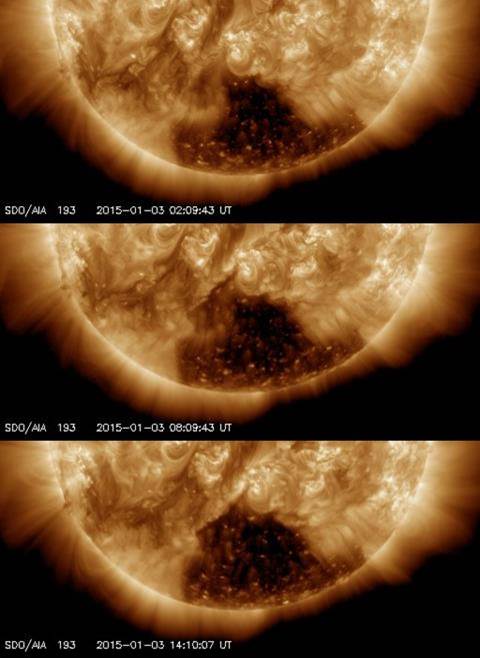
The above script is certainly not the final one. No space weather forecaster would predict such a strong storm based on the EUV and coronagraphic images, if any impact would have been predicted at all. Indeed, the most pressing question is how such a weak CME can have such intense magnetic fields at Earth, and cause such a strong geomagnetic storm. Maybe, the 3 January CME got scooped up by the fast stream of the nearby CH. Or the conditions were such that the erupting flux rope efficiently could compress the magnetic sheat that was in front of it as it lifted off the Sun. At any rate, the last word on this curious case has not been said. Events as these underscore that we still have no full understanding on the origin of heliospheric disturbances that may affect space weather conditions at Earth.
On January 7, an ICME struck the earth by surprise, as can be read in 'Report on Geomagnetic Activity' of this STCE Newsletter.
The GNSS Research Group of the Royal Observator of Belgium measured that day a sudden increase of the Total Electron Content (TEC) in their 3 stations.
The ionosphere is crucial for satellite navigation systems: satellite signals may be delayed, redirected, ... or simply said: messed up.
The picture below shows the disturbances of the ionosphere associated with the TEC: the biggest mess at that moment is located above Ireland.
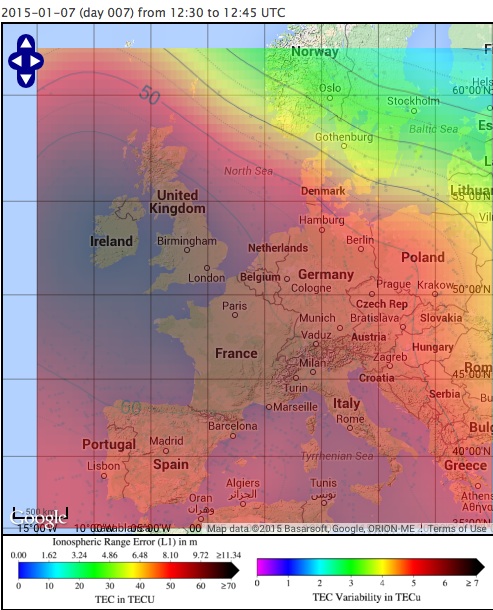
Check the event on
http://www.gnss.be/Atmospheric_Maps/ionospheric_event.php?date=2015-01-07
Dear Colleagues,
The European Space Weather Week (ESWW) is the European forum for Space Weather users, forecasters, scientists and the involved industries, as proven by the high attendance to the ESWW 11 in November 2014.
The ESWW 12 will be held in Belgium during the second part of November 2015 and its organisation has already started and is benefitting from the experience and inputs from the past editions.
Hence, to get a rich and varied meeting programme that spans all the aspects of Space Weather, from the observations and underpinning science to the operational models and industrial challenges, we invite you to submit proposals for sessions that are relevant to this framework.
Session proposals can be electronically submitted on the web page:
http://www.stce.be/esww12/sessioncall.php
The deadline for submission is 31 January 2015.
With Kind Regards,
Mauro Messerotti, Chair ESWW Programme Committee
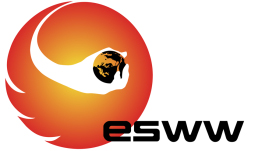
Solar flare activity remained low during the week.
In order to view the activity of this week in more detail, we suggest to go to the following website from which all the daily (normal and difference) movies can be accessed: http://proba2.oma.be/ssa
This page also lists the recorded flaring events.
A weekly overview movie can be found here (SWAP week 250).
http://proba2.oma.be/swap/data/mpg/movies/weekly_movies/weekly_movie_2015_01_05.mp4
Details about some of this week's events, can be found further below.
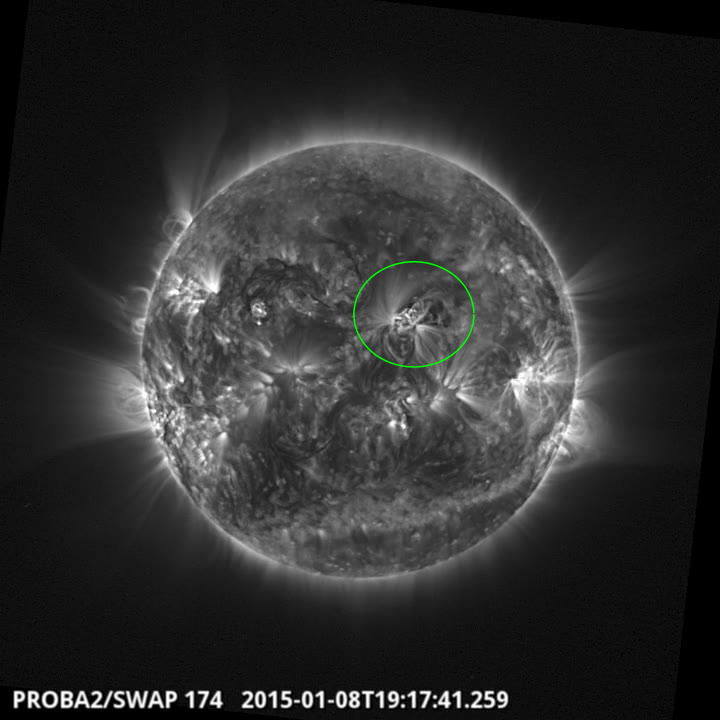
Failed eruption on the north west quad @ 19:17 SWAP image
Find a movie of the event here (SWAP movie)
http://proba2.oma.be/swap/data/mpg/movies/20150108_swap_movie.mp4
Solar activity was mostly low over the course of the week. 41 C flares were recorded of which 2 of C9 level.
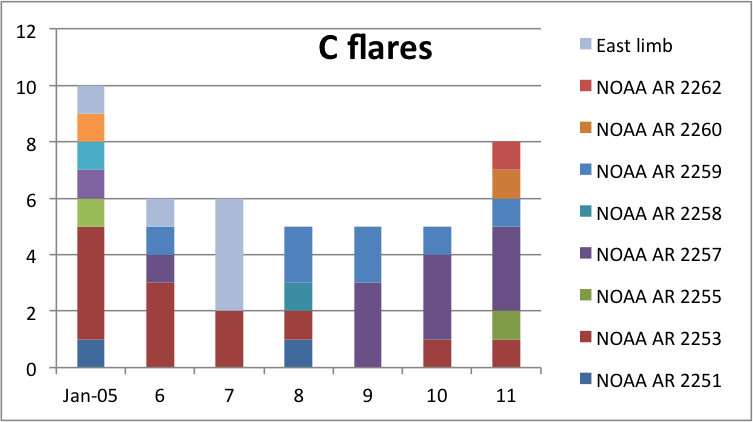
At the start of the week these were predominantly originating from AR 2253, which however slowly decayed as it crossed the western hemisphere. AR 2257 emerged just left of the central meridian in the beginning of the week and dominated the flaring activity for the remainder of the week (including a C9.6 flare peaking at 08:17 UT on January 9). The three pictures below are SDO/HMI magneto gram in which you can see the emergence of AR 2257.
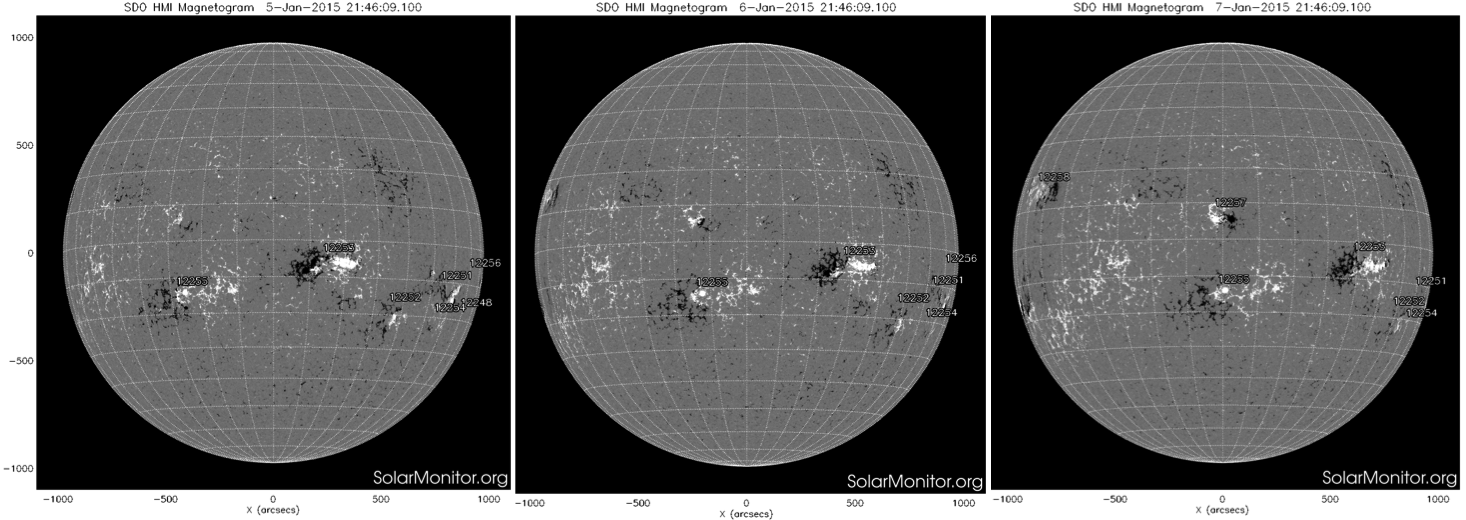
AR 2259 produced a C9.7 when it was still on the eastern limb on January 6, 11:48 UT, but afterwards only produced a couple of low level C flares. Some new flux emergence was observed in the western hemisphere in last couple of days. With the potential M class flaring from the regions in the western hemisphere a warning condition for proton events was maintained during most of the week.
Solar wind was expecting to see some influence of coronal hole high speed streams. But most prominently for the week an ICME struck by surprise on January 7. Around 5:30 UT a first sudden and later further continuous increase of the magnetic field to values of 23nT occurred. It was first accompanied by a pronounced and consistently negative Bz-component of down to -21nT. Some rotation of the magnetic fields was observed during the CME passage as Bz changed smoothly from firmly negative to firmly positive.
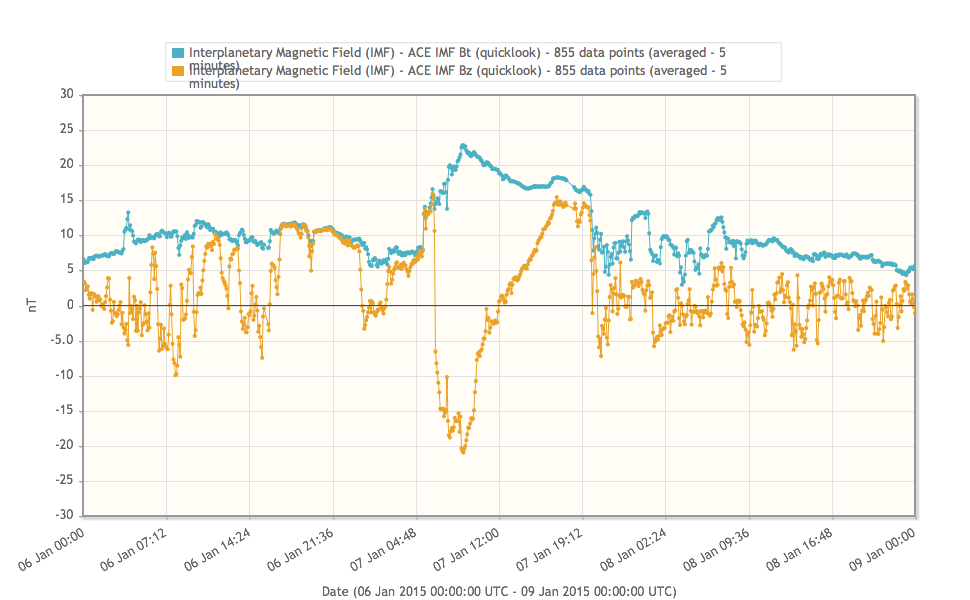
No shock in density or speed was associated with the event. For the remainder of the week solar wind conditions were mostly elevated due to moderately high speed stream influence.
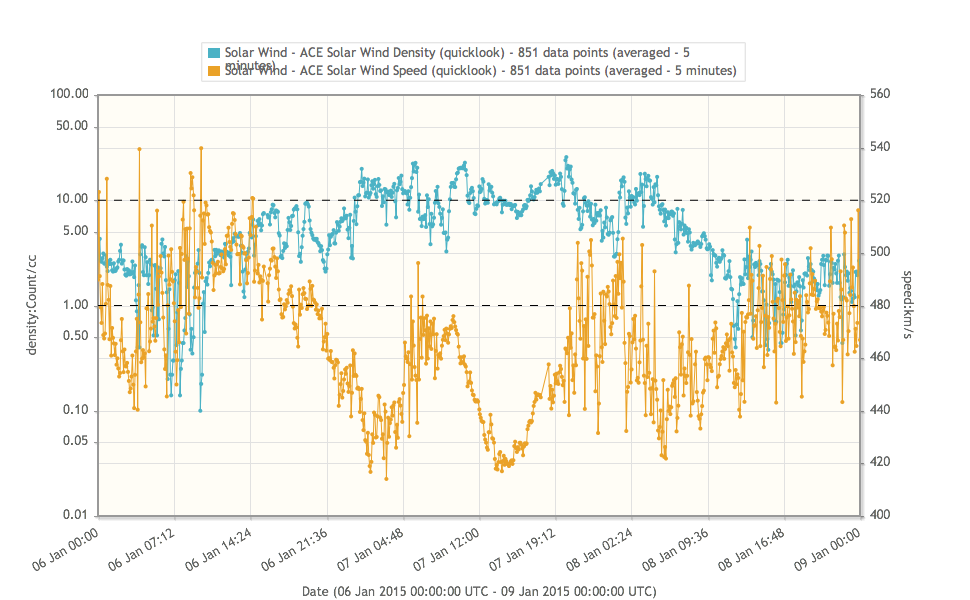
Associated with the ICME event a moderate to strong geomagentic storm was recorded (NOAA Kp up to 7, local K Dourbes up to 6). Geomagnetic conditions were quiet to unsettled for the remainder of the week.
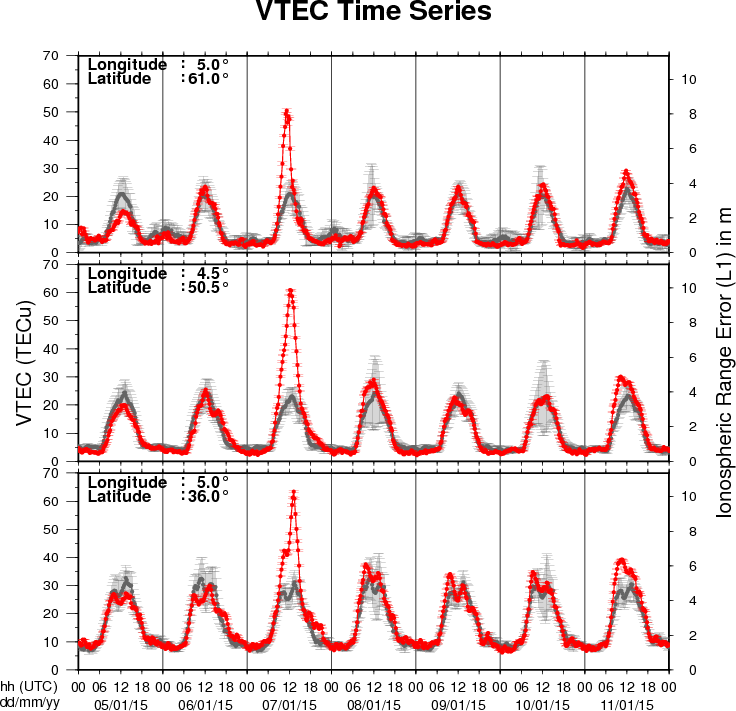
The figure shows the time evolution of the Vertical Total Electron Content (VTEC) (in red) during the last week at three locations:
a) in the northern part of Europe(N61°, 5°E)
b) above Brussels(N50.5°, 4.5°E)
c) in the southern part of Europe(N36°, 5°E)
This figure also shows (in grey) the normal ionospheric behaviour expected based on the median VTEC from the 15 previous days.
The VTEC is expressed in TECu (with TECu=10^16 electrons per square meter) and is directly related to the signal propagation delay due to the ionosphere (in figure: delay on GPS L1 frequency).
The Sun's radiation ionizes the Earth's upper atmosphere, the ionosphere, located from about 60km to 1000km above the Earth's surface.The ionization process in the ionosphere produces ions and free electrons. These electrons perturb the propagation of the GNSS (Global Navigation Satellite System) signals by inducing a so-called ionospheric delay.
See http://stce.be/newsletter/GNSS_final.pdf for some more explanations ; for detailed information, see http://gnss.be/ionosphere_tutorial.php
Start : 2015-03-16 - End : 2015-03-19
This international conference will provide an overview of our
current understanding of Sun-Climate Connections starting at
processes on the Sun itself over space weather and solar wind
towards solar influence on the upper atmosphere down to the ocean.
It will also provide insights into the heatedly debated role of the
Sun in climate change. In four sessions the various contributions
of solar variability influence on Earth's climate will be presented
and discussed by bringing together solar physicists, space
scientists, atmospheric scientists, climate modellers, and
paleoclimatologists.
We expect contributions from scientists participating in
SCOSTEP/ROSMIC, SPARC-SOLARIS/HEPPA, the EU cost network TOSCA, as
well as any other interested scientists. The conference will last
three full days, beginning Monday morning, 16 March 2013. The
programme will consist of invited and keynote lectures, a few
contributed oral presentations and ample time dedicated to poster
sessions. The fourth day will be devoted to public outreach
activities as well as panel discussions.
Website: http://scc.geomar.de/
Start : 2015-05-18 - End : 2015-05-22
URSI AT-RASC 2015 will be the first edition of the newly
established triennial URSI Atlantic Radio Science Conference as one
of the URSI Flagship Conferences. AT-RASC 2015 will have an open
scientific program composed of submitted papers within the domains
covered by all ten Commissions of URSI.
Website: http://www.at-rasc.com/
Start : 2015-06-01 - End : 2015-07-24
The Space Weather Summer School at Los Alamos National
Laboratory, established in 2011 under the founding Director Josef
Koller, is dedicated to space weather, space science and
applications. Every year we solicit applications for the Los Alamos
Space Weather Summer School. This summer school is sponsored and
supported by a number or organizations at LANL. This year our top
sponsors include the Los Alamos Institute of Geophysics, Planetary
Physics and Signatures (IGPPS) and the Laboratory Directed Research
and Development Office (LDRD). The summer school brings together
top space science students with internationally recognized
researchers at LANL in an educational and collaborative
atmosphere.
Website:
http://www.swx-school.lanl.gov/
Start : 2015-07-21 - End : 2015-07-23
The conference will review past and recent achievements, as well
as future challenges in the field of solar coronal loop
physics.
Website:
http://www.damtp.cam.ac.uk/user/astro/cl7/index.html
Start : 2015-07-28 - End : 2015-08-04
Heliophysics is all of the science common to the field of the
Sun-Earth connections. This fast-developing field of research
covers many traditional sub-disciplines of space physics,
astrophysics, and climate studies. The NASA Living with a Star
program, with its focus on the basic science underlying all aspects
of space weather, acts as a catalyst to bring the many research
disciplines together to deepen our understanding of the system of
systems formed by the Sun-Earth connection.
Website:
http://www.heliophysics.ucar.edu/
Start : 2015-07-30 - End : 2015-08-06
The 34th International Cosmic Ray Conference (ICRC) will be held
from July 30 to August 6, 2015, in The Hague, The Netherlands. It
is an important and large conference in the field of Astroparticle
Physics. The ICRC covers: cosmic-ray physics, solar and
heliospheric physics, gamma-ray astronomy, neutrino astronomy, and
dark matter physics.
Website: http://icrc2015.nl
Start : 2015-10-05 - End : 2015-10-09
This CSPM-2015 scientific meeting will cover various aspects of
solar dynamic and magnetic phenomena which are observed over the
entire electromagnetic spectrum: white-light, Hα, Ca II,
and radio from ground and in a variety of other wavelengths (white
light, UV and EUV, and X-rays) from space. Emphasis will also be
placed on instrumentation, observing techniques, and solar image
processing techniques, as well as theory and modelling through
detailed radiative transfer in increasingly realistic MHD models.
The long-term (cyclic) evolution of solar magnetism and its
consequence for the solar atmosphere, eruptive phenomena, solar
irradiation variations, and space weather, will be in focus. Here,
special attention will be devoted to the long-term observations
made in Coimbra and also to the results of the SPRING / SOLARNET
and SCOSTEP VarSITI studies. In particular, the weak solar activity
during the current solar maximum will be discussed. Finally, since
this meeting is organised around the 90th anniversary of performing
the first spectroheliographic observations in Coimbra, a session
will be specially dedicated to new solar instruments (both
ground-based and space-borne) that will give access to unexplored
solar atmospheric features and dynamic phenomena over the coming
years.
Website:
http://www.mat.uc.pt/~cspm2015/
Start : 2016-07-30 - End : 2016-08-07
The 41st COSPAR Scientific Assembly will be held in Istanbul,
Turkey from 30 July - 7 August 2016. This Assembly is open to all
bona fide scientists.
Website:
https://www.cospar-assembly.org/